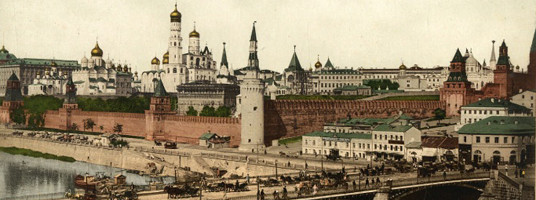History of the Moscow Kremlin

The first written record of Moscow goes back to 1147. It was then that the first fortifications began to appear on the site of the present-day Kremlin. Later on the Kremlin was rebuilt many times involving the erection of magnificent monasteries, cathedrals and palaces. During the reign of the Grand Prince Dmitry Donskoy in 2nd half of 14th century original wooden walls were replaced by first white stone walls. A century later, under Ivan III of Russia (Ivan the Great) they were dismantled and new burnt-brick walls were erected instead. Accession of new lands at that time demarcated the territory of the Kremlin as it is today. Another reconstruction during late 17th century finalized the Kremlin ensemble. The Patriotic war of 1812 caused severe damage to the Kremlin. While retreating the French army blew up several buildings and towers. It took more than two decades to complete the restoration. The Kremlin was badly damaged again during the armed uprising in Moscow during October-November 1917. The detachments of junior officers located there came under the artillery attack.
In March 1918 the Kremlin housed the Soviet government as the capital was moved to Moscow. During 1920s - 1960s the architectural ensemble of the Moscow Kremlin suffered great destruction involving demolishing of the monument to Grand Prince Sergey Alexandrovich and Emperor Alexander II, the chapel of Spasskaya (Saviour), Nikolskaya (Nicholas) and Borovitskaya towers, the Church of St. Constantine and Helen, the Chudov Monastery and the Ascension Convent, the Small Nicholas (Nikolayevsky) Palace, the Church of the Annunciation, the Cathedral of the Savior in the Pine Forest, and the Old Armory.
In 1991 the Kremlin became the residence of the President of Russia und underwent repairs between 1990s - 2000s. In 2016, the 14th building of the Kremlin, erected on the site of the former Small Nicholas Palace, the Chudov Monastery and the Ascension Convent, was dismantled. The project of restoration of destroyed buildings was put forward, however it was officially abandoned in 2017. At present, "archaeological windows" available for public in the area showcase remaining foundations of the Small Nicholas Palace and the Chudov Monastery.
The collection presents studies of the late 19th - early 20th cc., which cast light on the history of the Moscow Kremlin and its sights; archival materials, which spotlight the restoration of the Kremlin buildings in the Russian Empire; plans and technical drawings, including those that documented how the Kremlin was destroyed in 1812; along with albums, photographs and postcards with views of the Kremlin and Red Square covering different periods.





